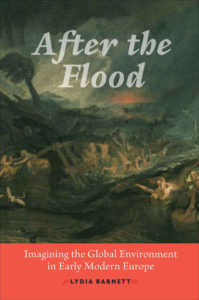 While today we often hear it said (by me, for one) that the mixing of religion and science is best avoided, not so long ago, the intermingling of religious and early scientific thought was not only common, it was in some instances – if for no other reason than due to the conflict it inspired – productive of entirely new concepts and ways of thinking about the world. In the early modern period, one of these productive interminglings involved the Old Testament story of the world-encompassing flood as recounted in the book of Genesis.
While today we often hear it said (by me, for one) that the mixing of religion and science is best avoided, not so long ago, the intermingling of religious and early scientific thought was not only common, it was in some instances – if for no other reason than due to the conflict it inspired – productive of entirely new concepts and ways of thinking about the world. In the early modern period, one of these productive interminglings involved the Old Testament story of the world-encompassing flood as recounted in the book of Genesis.
Prof. Lydia Barnett takes this as the central focus of her new book After the Flood; Imagining the Global Environment in Early Modern Europe in which she examines the ways in which “the biblical story of Noah’s Flood became a vehicle for imagining the power of sin to wreck the world, the dangers of overpopulation, the transformative effects of shifting landforms on the course of human history, and the impact of a changing climate on human bodies, health, and lives.”
As one with interests in the history of natural history, intellectual history, and a particular curiosity about the remarkable shifts in a number of paradigms that took place during the European early modern period, I was instantly drawn to this book when it was first brought to my attention through an interview with Prof. Barnett via one of the New Books Network’s podcasts. A copy has now reached my desk, and I am very eager to discover more about the good professor’s intriguing thesis.
If you enjoyed reading this, please consider signing up for The Well-read Naturalist's newsletter. You'll receive a helpful list of recently published reviews, short essays, and notes about books in your e-mail inbox once each fortnight.
